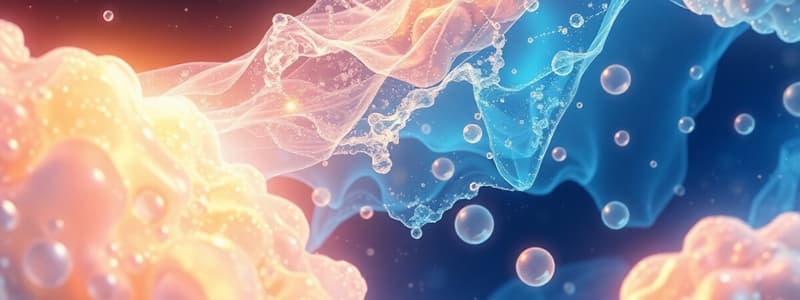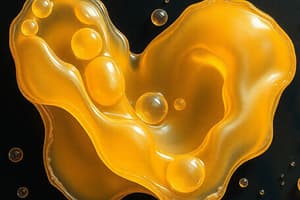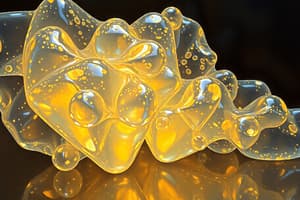Podcast
Questions and Answers
What is a significant challenge of using chitosan (CS) in hydrogel applications?
What is a significant challenge of using chitosan (CS) in hydrogel applications?
- Poor swelling capacity
- Limited availability of materials
- Lack of mechanical strength (correct)
- High degradation rate
Which of the following polymers is commonly used in the formation of hydrogels?
Which of the following polymers is commonly used in the formation of hydrogels?
- Polyvinyl chloride
- Nylon
- Polyurethane (correct)
- Polystyrene
What determines the applicability of hydrogels in commercial products such as diapers?
What determines the applicability of hydrogels in commercial products such as diapers?
- Color and appearance
- Odor retention
- Rate and degree of swelling (correct)
- Temperature stability
Which model is most commonly used to describe the kinetics of hydrogel swelling?
Which model is most commonly used to describe the kinetics of hydrogel swelling?
What type of biopolymers are mainly used for the synthesis of hydrogels?
What type of biopolymers are mainly used for the synthesis of hydrogels?
What can be added to hydrogels to improve their mechanical strength?
What can be added to hydrogels to improve their mechanical strength?
Why do dried hydrogels take time to reach swelling equilibrium?
Why do dried hydrogels take time to reach swelling equilibrium?
Which substance is used to adjust pH when preparing hydrogel solutions?
Which substance is used to adjust pH when preparing hydrogel solutions?
What is the primary component of the hydrogels discussed?
What is the primary component of the hydrogels discussed?
Which hydrogel formation status describes CS1Gl0.4?
Which hydrogel formation status describes CS1Gl0.4?
How is the Equilibrium Water Content (EWC) of the hydrogel calculated?
How is the Equilibrium Water Content (EWC) of the hydrogel calculated?
What does the equation ES% represent in the context of hydrogels?
What does the equation ES% represent in the context of hydrogels?
What method is referenced for yielding the kinetic order and rate of swelling of CS hydrogels?
What method is referenced for yielding the kinetic order and rate of swelling of CS hydrogels?
Which of the following describes the hydrogel CS1Gl0.6?
Which of the following describes the hydrogel CS1Gl0.6?
What does Wdr stand for in the equations related to hydrogel properties?
What does Wdr stand for in the equations related to hydrogel properties?
What is the relationship between Wsw and Wdr in calculating ES%?
What is the relationship between Wsw and Wdr in calculating ES%?
What indicates that the swelling of the hydrogel follows first-order kinetics?
What indicates that the swelling of the hydrogel follows first-order kinetics?
Which of the following equations represents the first-order kinetics of hydrogel swelling?
Which of the following equations represents the first-order kinetics of hydrogel swelling?
What does the variable $k_{1r}$ represent in the context of hydrogel swelling?
What does the variable $k_{1r}$ represent in the context of hydrogel swelling?
In the second-order kinetics equation of hydrogel swelling, what is represented by the term $(Seq - S)^2$?
In the second-order kinetics equation of hydrogel swelling, what is represented by the term $(Seq - S)^2$?
How can one confirm that the swelling process follows second-order kinetics?
How can one confirm that the swelling process follows second-order kinetics?
What experimental condition is used to assess the swelling ratio of the hydrogel?
What experimental condition is used to assess the swelling ratio of the hydrogel?
What is the significance of an $R^2$ value approaching 1 in the swelling study?
What is the significance of an $R^2$ value approaching 1 in the swelling study?
What determines the rate of swelling according to first-order kinetics?
What determines the rate of swelling according to first-order kinetics?
What does the parameter So represent in the swelling equation?
What does the parameter So represent in the swelling equation?
At which pH does chitosan (CS) demonstrate the best swelling according to the observed data?
At which pH does chitosan (CS) demonstrate the best swelling according to the observed data?
What happens to the swelling parameter S if there is desorption occurring?
What happens to the swelling parameter S if there is desorption occurring?
Which equation describes the swelling behavior of the hydrogel over time?
Which equation describes the swelling behavior of the hydrogel over time?
What would make chitosan (CS) insoluble according to its pKa value?
What would make chitosan (CS) insoluble according to its pKa value?
What was the observed range of swelling percentage for uncrosslinked CS beads at pH 7 in this study?
What was the observed range of swelling percentage for uncrosslinked CS beads at pH 7 in this study?
What morphological change occurs in the flat 2D shaped film of chitosan after absorbing water?
What morphological change occurs in the flat 2D shaped film of chitosan after absorbing water?
What characteristic of CS limits its swelling in alkaline pH?
What characteristic of CS limits its swelling in alkaline pH?
What is the primary reason for the weight loss at temperatures around 160°C in polymers?
What is the primary reason for the weight loss at temperatures around 160°C in polymers?
Which temperature range shows the maximum weight loss for the polymer?
Which temperature range shows the maximum weight loss for the polymer?
What effect does chemical modification typically have on the thermal stability of chitosan?
What effect does chemical modification typically have on the thermal stability of chitosan?
What happens to complex molecules during the second stage decomposition of the polymer?
What happens to complex molecules during the second stage decomposition of the polymer?
What was the observed impact of modifying chitosan with glutaraldehyde and sulfuric acid?
What was the observed impact of modifying chitosan with glutaraldehyde and sulfuric acid?
What is a critical factor affecting weight loss in polymers during thermal exposure?
What is a critical factor affecting weight loss in polymers during thermal exposure?
At what percentage weight loss does the initial stage of decomposition occur?
At what percentage weight loss does the initial stage of decomposition occur?
What is the significance of chemical modifications to the properties of chitosan?
What is the significance of chemical modifications to the properties of chitosan?
What does the endothermic peak in the analysis of CS relate to?
What does the endothermic peak in the analysis of CS relate to?
What can be inferred if the R2 values for First Order Kinetics approach 1?
What can be inferred if the R2 values for First Order Kinetics approach 1?
Which peak represents the degradation/melting of the main chain of CS?
Which peak represents the degradation/melting of the main chain of CS?
Which statement about second order kinetics in CS hydrogels is true?
Which statement about second order kinetics in CS hydrogels is true?
What reaction occurs between CS and glutaraldehyde that can be confirmed by a new peak?
What reaction occurs between CS and glutaraldehyde that can be confirmed by a new peak?
What do the R2 values indicate when comparing first order and second order kinetics?
What do the R2 values indicate when comparing first order and second order kinetics?
What does a graph of 'ln(Seq/(Seq-S))' against 't' represent for CS hydrogels?
What does a graph of 'ln(Seq/(Seq-S))' against 't' represent for CS hydrogels?
What does the two-stage decomposition process in CS crosslinked with glutaraldehyde indicate?
What does the two-stage decomposition process in CS crosslinked with glutaraldehyde indicate?
Flashcards
Hydrogels
Hydrogels
Hydrogels are hydrophilic polymer networks that absorb water.
Synthetic Polymers
Synthetic Polymers
Synthetic polymers in hydrogels include acrylic acid, acrylamide, polyurethane, and poly(ethylene glycol).
Natural Polymers
Natural Polymers
Natural polymers like cellulose, dextran, starch, and chitosan are used in hydrogel synthesis.
Swelling Ability of Hydrogels
Swelling Ability of Hydrogels
Signup and view all the flashcards
Fickian Diffusion Model
Fickian Diffusion Model
Signup and view all the flashcards
Mechanical Strength of CS Hydrogels
Mechanical Strength of CS Hydrogels
Signup and view all the flashcards
Crosslinking
Crosslinking
Signup and view all the flashcards
Mathematical Modeling of Swelling
Mathematical Modeling of Swelling
Signup and view all the flashcards
CS hydrogel notation
CS hydrogel notation
Signup and view all the flashcards
Equilibrium Water Content (EWC)
Equilibrium Water Content (EWC)
Signup and view all the flashcards
Hydrogel Swelling Kinetics
Hydrogel Swelling Kinetics
Signup and view all the flashcards
ES%
ES%
Signup and view all the flashcards
Flaccid Hydrogel
Flaccid Hydrogel
Signup and view all the flashcards
Firm Hydrogel
Firm Hydrogel
Signup and view all the flashcards
Highly viscous Hydrogel
Highly viscous Hydrogel
Signup and view all the flashcards
Swelling Kinetics Order
Swelling Kinetics Order
Signup and view all the flashcards
Swelling of CS hydrogel
Swelling of CS hydrogel
Signup and view all the flashcards
CS hydrogel at time t
CS hydrogel at time t
Signup and view all the flashcards
Kinetic constant (k1)
Kinetic constant (k1)
Signup and view all the flashcards
Characteristic constant (k2)
Characteristic constant (k2)
Signup and view all the flashcards
Exponential association model
Exponential association model
Signup and view all the flashcards
Kinetic constant kR2
Kinetic constant kR2
Signup and view all the flashcards
Swelling in acidic conditions
Swelling in acidic conditions
Signup and view all the flashcards
Chitosan (CS) solubility
Chitosan (CS) solubility
Signup and view all the flashcards
First-order kinetics equation
First-order kinetics equation
Signup and view all the flashcards
First-order kinetics plot
First-order kinetics plot
Signup and view all the flashcards
Second-order swelling kinetics
Second-order swelling kinetics
Signup and view all the flashcards
Second-order kinetics equation (integrated form)
Second-order kinetics equation (integrated form)
Signup and view all the flashcards
Swelling ratio (SR)
Swelling ratio (SR)
Signup and view all the flashcards
Equilibrium swelling
Equilibrium swelling
Signup and view all the flashcards
Rate constant (k1r, k2r)
Rate constant (k1r, k2r)
Signup and view all the flashcards
Hydrogel Swelling
Hydrogel Swelling
Signup and view all the flashcards
Thermal Stability of CS
Thermal Stability of CS
Signup and view all the flashcards
First Stage Decomposition
First Stage Decomposition
Signup and view all the flashcards
Second Stage Decomposition
Second Stage Decomposition
Signup and view all the flashcards
Weight Loss in CS
Weight Loss in CS
Signup and view all the flashcards
Chemical Modification of CS
Chemical Modification of CS
Signup and view all the flashcards
Glutaraldehyde & Sulfuric Acid
Glutaraldehyde & Sulfuric Acid
Signup and view all the flashcards
Effect of Modification on CS
Effect of Modification on CS
Signup and view all the flashcards
Thermal Stability & Applicability
Thermal Stability & Applicability
Signup and view all the flashcards
Endothermic Peak in DSC
Endothermic Peak in DSC
Signup and view all the flashcards
Exothermic Peak in DSC
Exothermic Peak in DSC
Signup and view all the flashcards
First Order Kinetics
First Order Kinetics
Signup and view all the flashcards
Second Order Kinetics
Second Order Kinetics
Signup and view all the flashcards
R2 Values
R2 Values
Signup and view all the flashcards
Schiff Base Formation
Schiff Base Formation
Signup and view all the flashcards
Covalent Crosslinking
Covalent Crosslinking
Signup and view all the flashcards
Fick's Law
Fick's Law
Signup and view all the flashcards
Study Notes
Kinetics, Absorption, and Diffusion Mechanism of Crosslinked Chitosan Hydrogels
- Chitosan hydrogels are useful for environmental applications
- Crosslinked and physical hydrogels were synthesized
- Swelling of disc-shaped crosslinked hydrogels using glutaraldehyde was compared to physical film and bead hydrogels
- Best swelling (around 3000%) observed in square film hydrogels, but they lacked rigidity
- Crosslinked hydrogels with higher crosslinker concentration trapped less water but had better mechanical strength
- Characterization of synthesized crosslinked hydrogels used FTIR, TGA, and DSC
- Equilibrium swelling higher at acidic pH (2.5)
- Increased temperature enhances swelling degree
- Hydrogels absorb more water with lower molar salt concentrations
- Second-order kinetics was observed due to stress relaxation of polymeric chains
- Diffusion was anomalous (exponent values between 0.5 and 1)
- Peleg's and Exponential models used for absorption modeling
- High swelling ability, biocompatibility, and available oxygen and nitrogen (lone pairs) on the CS surface make it ideal for drug delivery, fertilizer release, and contaminant adsorption
Introduction
- Hydrogels are 3-dimensional hydrophilic polymeric networks where water acts as a dispersion medium
- Superabsorbent polymers are a type of hydrogel with high water swelling (>100%)
- Hydrophilicity is due to polar groups like -OH, -CONH-, -COOH, -SO3H
- Natural polymers, such as cellulose, dextran, starch, and chitosan (CS), can be used for hydrogel synthesis
- Many commercial hydrogels are acrylic-based and take significant time to degrade
- Biodegradable and less toxic hydrogels are researched for industrial and commercial uses
Materials and Methods
- Materials: Chitosan (CS), glutaraldehyde, acetic acid
- Synthesis of uncrosslinked CS beads: CS mixed with acetic acid, added dropwise to NaOH bath (precipitating bath), left for hardening
- Synthesis of uncrosslinked CS films: CS and acetic acid mixture poured over a petri dish to form film
- Synthesis of crosslinked CS disc hydrogels: CS with gradually increasing concentrations of glutaraldehyde mixed, added to test tubes, resulted in hydrogel formation
- Swelling studies: Used gravimetric measurements to assess swelling. Discs placed in distilled water at various pH values and temperatures
- Characterization methods: FTIR spectroscopy, Thermogravimetric Analysis (TGA), Differential Scanning Calorimetry (DSC).
Results and Discussion
- Effect of pH: Swelling increased at acidic (pH 2.5) and decreased at alkaline (pH 10.5) conditions
- Effect of temperature: Higher temperatures generally led to higher swelling
- Effect of ionic strength: Higher ionic strength (salt concentration) typically led to reduced swelling
- FTIR: Verified presence of hydroxyl groups, indicative of hydrophilicity. Also showed amide II and C-O-C stretching, common in carbohydrate structures
- TGA & DSC: First stage weight loss (around 12%) attributed to water evaporation from the network. Second stage loss associated with degradation around 225-298°C. Peak around 266°C indicated main chain degradation
Swelling Kinetics
- First-order and Second-order kinetics: Determined the order of kinetics by plotting data and examining R² values and found most results followed second order.
- Diffusion mechanism: Diffusion of water in the hydrogel network is analyzed using Fick's laws determining water diffusion rates for different conditions
- Absorption kinetics modeling: The two most common models: Peleg's model and Exponential association model were used.
- High R² values indicated that Peleg's model better reflected observed absorption behavior.
Conclusion
- Different physical and chemical approaches were used to synthesize CS hydrogels
- Swelling behavior significantly affected by pH, temperature, and ionic strength of the surrounding medium
- Swelling kinetics were explored, indicating second order kinetics.
- The properties of these CS hydrogels show promise for various applications, particularly in controlled release systems.
Studying That Suits You
Use AI to generate personalized quizzes and flashcards to suit your learning preferences.




